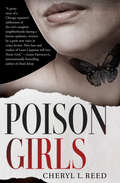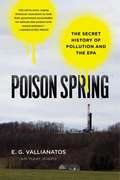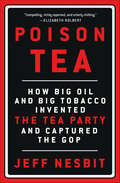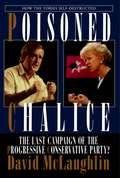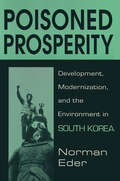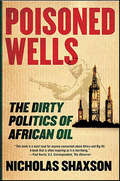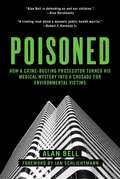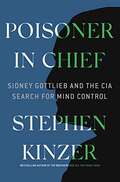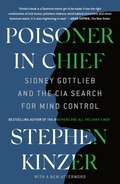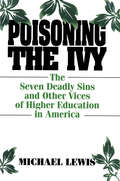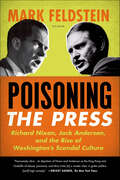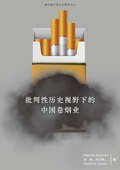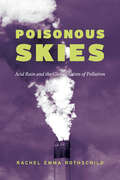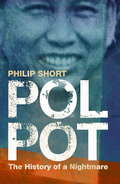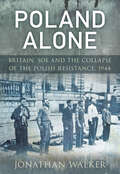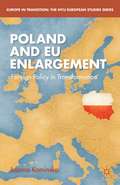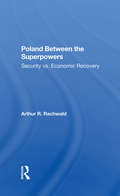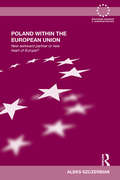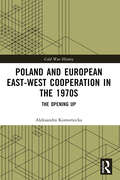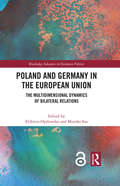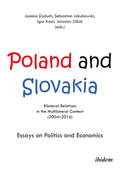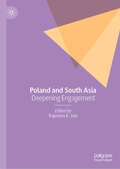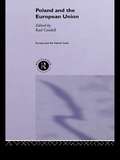- Table View
- List View
Poison
by Bridget ZinnWhen sixteen-year-old Kyra, a potions master, tries to save her kingdom by murdering the princess, who is also her best friend, the poisoned dart misses its mark and Kyra becomes a fugitive, pursued by the King's army and her ex-boyfriend Hal.
Poison Girls
by Cheryl L. Reed“A great new voice in crime fiction. Noir fans and readers of Laura Lippman will love Poison Girls” (Jamie Freveletti, international-bestselling author of Blood Run). It’s the summer of 2008. Chicago’s Hyde Park Senator is running for the White House, the city is vying to host the 2016 Summer Olympics, and “Poison,” a lethal form of heroin, has killed more than 250 people, including dozens of suburban girls from prominent families. Natalie Delaney, a crime reporter from the Chicago Times, discovers that daughters of Democratic powerhouses are the real targets. Obsessed with finding who is behind the killings, Natalie becomes entangled in an underworld where drugs, cops, gangs, politics, and privilege collide. Risking everything, this reporter becomes the story . . . “Touching, salty, brutal, organized, lost, powerful and tragic.” —Janet Burroway, author of Writing Fiction “An ambitious book, noirish, Dickensian in a modern way, and rooted in the realistic tradition. It tells a complex story.” —Stuart Dybek, MacArthur Fellow and author of The Coast of Chicago
Poison Spring: The Secret History of Pollution and the EPA
by Mckay Jenkins E. G. VallianatosWhen you order a meal in a restaurant, you won't find malathion, kelthane or arsenic listed on the menu as an ingredient of your entrée, but these and scores of other pesticides and dangerous chemicals are in the food we eat. They are dumped into the environment where they seep into our water supply and float in the air we breathe. The use of these poisons is approved--or in some cases, simply ignored--by the Environmental Protection Agency. Poison Spring documents, in devastating detail, the EPA's corruption and misuse of science and public trust. In its half-century of existence, the agency has repeatedly reinforced the chemical-industrial complex by endorsing deadly chemicals, botching field investigations, turning a blind eye to toxic disasters, and swallowing the self-serving claims of industry. E. G. Vallianatos, who saw the EPA from the inside for more than two decades with rising dismay, reveals in Poison Spring how the agency has allowed our lands and waters to be poisoned with more toxic chemicals than ever. No one who cares for the natural world, or for the health of future generations, can ignore this powerful exposé.
Poison Tea: How Big Oil and Big Tobacco Invented the Tea Party and Captured the GOP
by Jeff Nesbit“Poison Tea shines a spotlight on the shadowy Koch brother network and reveals hidden connections between the tobacco industry, the reclusive billionaire brothers, and the Tea Party movement. It’s a major story that for too long has been underreported and poorly understood.”—REP. HENRY WAXMAN, a former chairman of the House Energy and Commerce CommitteeHow did today’s Tea Party movement really come to be? Did it suddenly appear in 2009 as a spontaneous response to Barack Obama and health-care reform? Or was its true purpose and history something far different. Was it in fact a careful, strategic effort by two of the planet’s wealthiest individuals, the tobacco industry, and other corporate interests to remake the government and seize control of one of our two national parties, ultimately gaining both the White House and Congress?Jeff Nesbit was in the room at the beginning of the unholy alliance between representatives of the world’s largest private oil company and the planet’s largest public tobacco company. There, they planned for a grassroots national political movement—one that would later be known as the Tea Party—that would promote their own corporate interests and political goals. Drawing from his own experience as well as from troves of recently released internal tobacco industry documents, Nesbit reveals the long game that these corporate giants have played to become a dominant force in American politics.
Poisoned Chalice: How the Tories Self-Destructed
by David MclaughlinPoisoned Chalice chronicles the fateful end of the federal Progressive Conservative government in Ottawa. The Progressive Conservative Party sought to remake itself by choosing the first woman prime minister in Canadian history, but failed to heed the lessons of Meech or Charlottetown. Their strategy nearly worked. By the time the election was called, the Tories were neck and neck with Jean Chrétien’s Liberals. Then it all fell apart. This book, published exactly one year after the event, tells how and why it happened. It gives a day-by-day account of an election campaign seemingly doomed to failure. It covers the strategy, tactics and political machinations that drove the Conservative campaign from the point of view of someone "on the bus." Read the strategy memos given to Kim Campbell. Listen in on her election-night phone call to Jean Chrétien. Relive Kim Campbell’s campaigh from one end of the country to the other. More than just that, Poisoned Chalice asks fundamental questions about how one of the founding political parties of Canada could come to such an ignominious state. Does the Progressive Conservative Party have a future? Has it been overtaken for good by Reform? This book takes the reader back to the seeds of the Tories’ defeat, from the constitutional debate and referendum, to the Conservative leadership race that never was, to Kim Campbell’s shining summer, to the electoral devastation of just two seats.
Poisoned Prosperity: Development, Modernization and the Environment in South Korea
by Norman R. EderA study of environmental degradation, this work presents the environmental problems of South Korea. The effects of rapid industrialisation and modernisation are documented along with the choices and actions which are available to the country.
Poisoned Wells: The Dirty Politics of African Oil
by Nicholas ShaxsonEach week the oil and gas fields of sub-Saharan Africa produce well over a billion dollars' worth of oil, an amount that far exceeds development aid to the entire African continent. Yet the rising tide of oil money is not promoting stability and development, but is instead causing violence, poverty, and stagnation. It is also generating vast corruption that reaches deep into American and European economies. In Poisoned Wells, Nicholas Shaxson exposes the root causes of this paradox of poverty from plenty, and explores the mechanisms by which oil causes grave instabilities and corruption around the globe. Shaxson is the only journalist who has had access to the key players in African oil, and is willing to make the connections between the problems of the developing world and the involvement of leading global corporations and governments.
Poisoned: How a Crime-Busting Prosecutor Turned His Medical Mystery into a Crusade for Environmental Victims
by Alan Bell Jan SchlichtmannAfter years of prosecuting hard-core criminals, rising legal star Alan Bell took a private sector job in South Florida’s newest skyscraper. Suddenly, he suffered such bizarre medical symptoms, doctors suspected he’d been poisoned by the Mafia. Bell’s rapidly declining health forced him to flee his glamorous Miami life to a sterile “bubble” in the remote Arizona desert. As his career and marriage dissolved, Bell pursued medical treatments in a race against time, hoping to stay alive and raise his young daughter, his one desperate reason to keep going. He eventually discovered he wasn’t poisoned by a criminal, but by his office building. His search for a cure led him to discover the horrifying truth: his tragedy was just the tip of the iceberg. Millions of people fall ill and die each year because of toxic chemical exposures—without knowing they’re at risk. Stunned by what he discovered, Bell chose to fight back, turning his plight into an opportunity. Despite his precarious health, he began collaborating with scientists dedicated to raising awareness about this issue. Soon, he also found himself drawn back into the legal field, teaming up with top lawyers fighting for those who had already fallen ill. Both a riveting medical mystery and a cautionary tale, this book puts a human face on the hidden truths behind toxic dangers assaulting us in our everyday environments—and offers practical ways to protect ourselves and our children.
Poisoner In Chief: Sidney Gottlieb And The Cia Search For Mind Control
by Stephen KinzerThe bestselling author of All the Shah’s Men and The Brothers tells the astonishing story of the man who oversaw the CIA’s secret drug and mind-control experiments of the 1950s and ’60s. The visionary chemist Sidney Gottlieb was the CIA’s master magician and gentlehearted torturer―the agency’s “poisoner in chief.” As head of the MK-ULTRA mind control project, he directed brutal experiments at secret prisons on three continents. He made pills, powders, and potions that could kill or maim without a trace―including some intended for Fidel Castro and other foreign leaders. He paid prostitutes to lure clients to CIA-run bordellos, where they were secretly dosed with mind-altering drugs. His experiments spread LSD across the United States, making him a hidden godfather of the 1960s counterculture. For years he was the chief supplier of spy tools used by CIA officers around the world. Stephen Kinzer, author of groundbreaking books about U.S. clandestine operations, draws on new documentary research and original interviews to bring to life one of the most powerful unknown Americans of the twentieth century. Gottlieb’s reckless experiments on “expendable” human subjects destroyed many lives, yet he considered himself deeply spiritual. He lived in a remote cabin without running water, meditated, and rose before dawn to milk his goats. During his twenty-two years at the CIA, Gottlieb worked in the deepest secrecy. Only since his death has it become possible to piece together his astonishing career at the intersection of extreme science and covert action. Poisoner in Chief reveals him as a clandestine conjurer on an epic scale.
Poisoner in Chief: Sidney Gottlieb and the CIA Search for Mind Control
by Stephen KinzerThe bestselling author of All the Shah’s Men and The Brothers tells the astonishing story of the man who oversaw the CIA’s secret drug and mind-control experiments of the 1950s and ’60s.The visionary chemist Sidney Gottlieb was the CIA’s master magician and gentlehearted torturer—the agency’s “poisoner in chief.” As head of the MK-ULTRA mind control project, he directed brutal experiments at secret prisons on three continents. He made pills, powders, and potions that could kill or maim without a trace—including some intended for Fidel Castro and other foreign leaders. He paid prostitutes to lure clients to CIA-run bordellos, where they were secretly dosed with mind-altering drugs. His experiments spread LSD across the United States, making him a hidden godfather of the 1960s counterculture. For years he was the chief supplier of spy tools used by CIA officers around the world.Stephen Kinzer, author of groundbreaking books about U.S. clandestine operations, draws on new documentary research and original interviews to bring to life one of the most powerful unknown Americans of the twentieth century. Gottlieb’s reckless experiments on “expendable” human subjects destroyed many lives, yet he considered himself deeply spiritual. He lived in a remote cabin without running water, meditated, and rose before dawn to milk his goats.During his twenty-two years at the CIA, Gottlieb worked in the deepest secrecy. Only since his death has it become possible to piece together his astonishing career at the intersection of extreme science and covert action. Poisoner in Chief reveals him as a clandestine conjurer on an epic scale.
Poisoning the Ivy: The Seven Deadly Sins and Other Vices of Higher Education in America
by Michael Lewis"This is a dirty book about higher education." So begins Michael Lewis's provocative new book, one that calls into question the conventional wisdom and about the excellence of American higher education. Lewis argues that teaching and research on America's campuses are plagued by mis- and malfeasance. He further argues that these troubles are the paradoxical implications of professorial self-conceptions. The academic claim of moral and ethical specialness, according to Lewis, unexpectedly creates an environment where hack work or even no work at all is tolerated and in some cases actually rewarded. Through his chapters on "The Seven Pedagogical Sins" and "The Bad Joke of Scholarship, " the author traces the trajectory of the effects of collective denial on the quality of education in America. In his final chapter, Lewis offers a series of reforms intended to reverse faculty permissiveness.
Poisoning the Press: Richard Nixon, Jack Anderson, and the Rise of Washington's Scandal Culture
by Mark FeldsteinIt is March 1972, and the Nixon White House wants Jack Anderson dead. The syndicated columnist Jack Anderson, the most famous and feared investigative reporter in the nation, has exposed yet another of the President's dirty secrets. Nixon's operatives are ordered to "stop Anderson at all costs"—permanently. Across the street from the White House, they huddle in a hotel basement to conspire. Should they try "Aspirin Roulette" and break into Anderson's home to plant a poisoned pill in one of his medicine bottles? Could they smear LSD on the journalist's steering wheel, so that he would absorb it through his skin, lose control of his car, and crash? Or stage a routine-looking mugging, making Anderson appear to be one more fatal victim of Washington's notorious street crime?Poisoning the Press: Richard Nixon, Jack Anderson, and the Rise of Washington's Scandal Culture recounts not only the disturbing story of an unprecedented White House conspiracy to assassinate a journalist, but also the larger tale of the bitter quarter-century battle between the postwar era's most embattled politician and its most reviled newsman. The struggle between Nixon and Anderson included bribery, blackmail, forgery, spying, and burglary as well as the White House murder plot. Their vendetta symbolized and accelerated the growing conflict between the government and the press, a clash that would long outlive both men.Mark Feldstein traces the arc of this confrontation between a vindictive president and a flamboyant, crusading muckraker who rifled through garbage and swiped classified papers in pursuit of his prey—stoking the paranoia in Nixon that would ultimately lead to his ruin. The White House plot to poison Anderson, Feldstein argues, is a metaphor for the poisoned political atmosphere that would follow, and the toxic sensationalism that contaminates contemporary media discourse. Melding history and biography, Poisoning the Press unearths significant new information from more than two hundred interviews and thousands of declassified documents and tapes. This is a chronicle of political intrigue and the true price of power for politicians and journalists alike. The result—Washington's modern scandal culture—was Richard Nixon's ultimate revenge.
Poisonous Pandas: Chinese Cigarette Manufacturing in Critical Historical Perspectives (Studies of the Walter H. Shorenstein Asia-Pacific Research Center)
by Matthew Kohrman, Gan Quan, Liu Wennan, and Robert N. ProctorPlease note that this is a Chinese language edition. A favorite icon for cigarette manufacturers across China since the mid-twentieth century has been the panda, with factories from Shanghai to Sichuan using cuddly cliché to market tobacco products. The proliferation of panda-branded cigarettes coincides with profound, yet poorly appreciated, shifts in the worldwide tobacco trade. Over the last fifty years, transnational tobacco companies and their allies have fueled a tripling of the world's annual consumption of cigarettes. At the forefront is the China National Tobacco Corporation, now producing forty percent of cigarettes sold globally. What's enabled the manufacturing of cigarettes in China to flourish since the time of Mao and to prosper even amidst public health condemnation of smoking? In Poisonous Pandas, an interdisciplinary group of scholars comes together to tell that story. They offer novel portraits of people within the Chinese polity—government leaders, scientists, tax officials, artists, museum curators, and soldiers—who have experimentally revamped the country's pre-Communist cigarette supply chain and fitfully expanded its political, economic, and cultural influence. These portraits cut against the grain of what contemporary tobacco-control experts typically study, opening a vital new window on tobacco—the single largest cause of preventable death worldwide today.
Poisonous Skies: Acid Rain and the Globalization of Pollution
by Rachel Emma RothschildThe climate change reckoning looms. As scientists try to discern what the Earth’s changing weather patterns mean for our future, Rachel Rothschild seeks to understand the current scientific and political debates surrounding the environment through the history of another global environmental threat: acid rain. The identification of acid rain in the 1960s changed scientific and popular understanding of fossil fuel pollution’s potential to cause regional—and even global—environmental harms. It showed scientists that the problem of fossil fuel pollution was one that crossed borders—it could travel across vast stretches of the earth’s atmosphere to impact ecosystems around the world. This unprecedented transnational reach prompted governments, for the first time, to confront the need to cooperate on pollution policies, transforming environmental science and diplomacy. Studies of acid rain and other pollutants brought about a reimagining of how to investigate the natural world as a complete entity, and the responses of policy makers, scientists, and the public set the stage for how societies have approached other prominent environmental dangers on a global scale, most notably climate change. Grounded in archival research spanning eight countries and five languages, as well as interviews with leading scientists from both government and industry, Poisonous Skies is the first book to examine the history of acid rain in an international context. By delving deep into our environmental past, Rothschild hopes to inform its future, showing us how much is at stake for the natural world as well as what we risk—and have already risked—by not acting.
Pol Pot: The History of a Nightmare
by Philip ShortPol Pot was an idealistic, reclusive figure with great charisma and personal charm. He initiated a revolution whose radical egalitarianism exceeded any other in history. But in the process, Cambodia desended into madness and his name became a byword for oppression.In the three-and-a-half years of his rule, more than a million people, a fifth of Cambodia's population, were executed or died from hunger and disease. A supposedly gentle, carefree land of slumbering temples and smiling peasants became a concentration camp of the mind, a slave state in which absolute obedience was enforced on the 'killing fields'. Why did it happen? How did an idealistic dream of justice and prosperity mutate into one of humanity's worst nightmares? Philip Short, the biographer of Mao, has spent four years travelling the length of Cambodia, interviewing surviving leaders of Pol Pot's Khmer Rouge movement and sifting through previously closed archives. Here, the former Khmer Rouge Head of State, Pol's brother-in-law and scores of lesser figures speak for the first time at length about their beliefs and motives.
Pol Pot: The History of a Nightmare
by Philip ShortPol Pot was an idealistic, reclusive figure with great charisma and personal charm. He initiated a revolution whose radical egalitarianism exceeded any other in history. But in the process, Cambodia desended into madness and his name became a byword for oppression.In the three-and-a-half years of his rule, more than a million people, a fifth of Cambodia's population, were executed or died from hunger and disease. A supposedly gentle, carefree land of slumbering temples and smiling peasants became a concentration camp of the mind, a slave state in which absolute obedience was enforced on the 'killing fields'. Why did it happen? How did an idealistic dream of justice and prosperity mutate into one of humanity's worst nightmares? Philip Short, the biographer of Mao, has spent four years travelling the length of Cambodia, interviewing surviving leaders of Pol Pot's Khmer Rouge movement and sifting through previously closed archives. Here, the former Khmer Rouge Head of State, Pol's brother-in-law and scores of lesser figures speak for the first time at length about their beliefs and motives.
Poland Alone: Britain, SOE and the Collapse of the Polish Resistance, 1944
by Jonathan WalkerPoland was the 'tripwire' that brought Britain into the Second World War but neither Britain, nor Poland's older ally, France, had the material means to prevent Poland being overrun. The broadcast, 'Poland is no longer alone' had a distinctly hollow ring. During the next four years the Polish Government in exile and armed forces made a significant contribution to the Allied war effort; in return the Polish Home Army received a paltry 600 tons of supplies. Poland Alone focuses on the climactic year of 1944 when the Polish Resistance attempted to gain control of Warsaw from the Germans. A bloody uprising ensued, but little help was received from the Allies. After the Warsaw Poles were massacred, the Red Army finally moved into the city and then occupied the whole country. Jonathan Walker examines whether Britain could have done more to save the Polish people and the victims of the Holocaust. While Allied political and military leaders clashed over the level of support for the Poles, SOE, RAF and Intelligence personnel fought a bitter covert war to help the Polish resistance fighters. The War ended with over five million Poles dead. Had Britain betrayed her ally?
Poland And Eu Enlargement
by Joanna KaminskaThis book analyzes changes in Polish foreign policy in the context of the EU membership, exploring Poland's transition from a policy taker to policy-maker. It focuses on how Poland shapes EU policy towards the Eastern neighbors.
Poland Between The Superpowers: Security Versus Economic Recovery
by Arthur R RachwaldThis book examines the foreign and domestic policies of Poland since World War II in light of the country's relations with the Soviet Union and the United States. Dr. Rachwald focuses on three salient goals of Polish foreign policy: security, guaranteed both by alliance with the Soviet Union and by support for the idea of European collective securi
Poland Within the European Union: New Awkward Partner or New Heart of Europe? (Routledge Advances in European Politics)
by Aleks SzczerbiakThis book examines the first five years of Polish EU membership. The combination of Poland’s potential power as a major, and possibly controversial, player in both the region and Europe as a whole, and the apparent salience of Euroscepticism in domestic electoral politics at the core of the Polish government and party system presented the possibility that Poland would be a ‘new awkward partner’ in Europe. However, although Poles may have voted for EU-critical parties in large numbers no ‘Eurosceptic backlash’ has emerged. In fact, far from being a ‘new awkward partner’, Poland has tried to portray itself as the ‘new heart of Europe’ and it certainly came to be increasingly perceived as such in Brussels and by its European allies. This book focuses on two linked questions. Firstly, what impact has Poland had upon the EU as a new member state? Secondly, how has becoming an EU member impacted upon public attitudes towards the EU and Polish domestic politics, particularly on its party and electoral politics? Szczerbiak provides the first detailed empirical case study of the impact of Poland’s EU membership on its politics and of Poland's impact on the EU. The book also makes broader theoretical contributions to our understanding of EU relations with its member states. As a result of the above, this book will be of interest to students and scholars of European Politics, political science and European integration.
Poland and European East-West Cooperation in the 1970s: The Opening Up (Cold War History)
by Aleksandra KomornickaThis book offers an international reading of the Polish socialist regime’s history in the 1970s, and its opening up to the West. It bridges Poland’s socialist domestic history with critical developments of the global and European 1970s, including détente in the Cold War, western European integration, and globalisation. In this period of international transformations, socialist Poland under Edward Gierek's leadership multiplied its economic and political contacts with capitalist countries, especially western Europe, and became a leader of East-West cooperation among Council for Mutual Economic Assistance and Warsaw Pact members. Relying on sources from public and corporate archives in five different European states, the book demonstrates both that the global political and economic transformations of that period were critical for the decision-making process in Poland and, moreover, that the national socialist elites participated in shaping these transformations. By looking at the goals and expectations of the Polish socialist elites and their practices of political and economic exchanges with western Europe, the book explains the logic which drove the socialist regime into entanglement with the West. As is shown here, this entanglement proved inextricable and critical for the socialist regime's failure and Poland’s political and economic future. This book will be of much interest to students of European history, cold war studies, socialism studies and International Relations.
Poland and Germany in the European Union: The Multidimensional Dynamics of Bilateral Relations (Routledge Advances in European Politics)
by Elżbieta OpiłowskaThis book explores the political and social dynamics of the bilateral relations between Germany and Poland at the national and subnational levels, taking into account the supranational dynamics, across such different policy areas as trade, foreign and security policy, energy, fiscal issues, health and social policy, migration and local governance. By studying the impact of the three explanatory categories – the historical legacy, interdependence and asymmetry – on the bilateral relationship, the book explores the patterns of cooperation and identifies the driving forces and hindering factors of the bilateral relationship. Covering the Polish–German relationship since 2004, it demonstrates, in a systematic way, that it does not qualify as embedded bilateralism. The relationship remains historically burdened and asymmetric, and thus it is not resilient to crises. This book will be of key interest to scholars and students of European and EU Politics, German politics, East/Central European Politics, borderlands studies, and more broadly, for international relations, history and sociology.
Poland and Slovakia (2004–2016): Essays on Politics and Economics
by Joanna Dyduch Sebastian Jakubowski Igor Kosír Jaroslav UšiakThis book investigates the complex relations between the Republic of Poland and the Slovak Republic in the context of ongoing processes in the European Union's political and economic system. The basic assumption of the study is that Polish-Slovak relations are affected and shaped not only by the interaction between the two of them but also by the dynamics of the European and global international environment. The authors explore different aspects of the interconnectedness of Warsaw and Bratislava. This includes the analysis of political, economic, and social dimensions of bilateral relations in the multilateral context. One of the goals of this volume is to define areas and spheres of Poland's and Slovakia's common interest, as well as to point out those areas with the highest potential for development. It also defines and analyzes problematic issues in common relations that could be seen as obstacles in developing cooperation in specific areas and politically strategic areas like foreign and security policy. Moreover, the book seeks to measure the extent to which Polish-Slovak relations are affected by the European integration process.
Poland and South Asia: Deepening Engagement
by Rajendra K. JainThis book explores the political, economic, defence, and cultural relations of Poland with South Asia—Afghanistan, Bangladesh, Bhutan, India, Myanmar, Nepal, Pakistan, and Sri Lanka—since the late 1940s to the present. It examines how Polish preoccupation with gaining admission to NATO and the European Union led South Asia to fade into the margins of Polish foreign policy. It discusses key narratives and perceptions of South Asia in the Polish media and thinktanks, features of the South Asian diaspora in Poland, and assesses future prospects of Warsaw’s deepening political and economic engagement with the region. The pioneering book will be essential reading for students and scholars of Central/East European studies, International Relations, Indian foreign policy, Polish-Asian politics and foreign policy.
Poland and the European Union (Europe and the Nation State #Vol. 15)
by Karl CordellThis authoritative volume assesses how the recently democratised political system in Poland is adapting to the challenges posed by the country's desire to "rejoin Europe". Its excellent panel of highly respected Polish academics considers various issues not generally well-known to the English-speaking world, but of great importance in the light of Poland's impending entry into the European Union.

